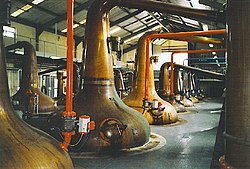Still
An internal bladder ( combustion boiler) is usually formed from copper hollow body for distillation, we speak here of burning, of low alcoholic and turbid fluids with 5 to 15 vol% (beer or wine) to clear spirits such as whiskey or cognac is used.
Burning process
The liquid in the pot still is heated so much by the continuous supply of heat, that the various alcohols and aromatic substances evaporate and condense again depending on the severity of the substance on the inside wall of the pot still and then either flow back into the thrips, or via the characteristic kink for further use in appropriate collection container (such as a spirit safe ) flow.
Often the resulting distillates are enhanced by multi-session after another. So Scottish whiskeys are usually twice, Irish whiskeys distilled three times. After the first pass, the distillate having about 25 to 35 vol %. Before filling into barrels the whiskey distillates then have about 70 % by volume.
Some stills have small windows in the neck by means of which the Master Distiller can monitor that, where appropriate, high foaming liquid does not boil too far. However, since this can only happen when there is still enough proteins in the liquid are, only the stills are provided with a window that will be used for the first distillation process.
From a technical perspective, the pot still has some drawbacks. It does not allow continuous distillation. For each Brennlos the focal bladder needs to be refilled and heated. Due to the low reflux being the fractionation, i.e. the discrimination between the desired and undesired components, is not particularly good. This requires two or three times firing in order to obtain a sufficiently pure strong and fire. With very high quality mashing many flavorful desired components are obtained just by the weak selectivity, however. Therefore, the classic pot still continues to be used for high-quality spirits such as malt whiskey.
Form
Stills can differ widely in their shape and dimension. Generally, however, they have a massive, spherical foot, from the going a different long neck upwards. Neck and feet are usually an additional bead or a waist separated by either. The neck itself tapers upwards more and more and finally bent to about 90 ° downwards.
Terms of Use
The operation of a distillery is subject to the distillery order, an annex to the spirits monopoly. According to § 46 Branntweinmonopolgesetz in conjunction with § 227 of the distillery order individuals are exempt from to log stills at customs, if a maximum volume of 0.5 l is not exceeded. However, this does not exempt them from the tax on spirits. The duty on the alcohol can be obtained from the competent customs office.








